AMD Athlon 64 4000+ & FX-55: A Thorough Investigation
by Anand Lal Shimpi on October 19, 2004 1:04 AM EST- Posted in
- CPUs
Multitasking Content Creation
MCC Winstone 2004
Multimedia Content Creation Winstone 2004 tests the following applications in various usage scenarios:
. Adobe® Photoshop® 7.0.1
. Adobe® Premiere® 6.50
. Macromedia® Director MX 9.0
. Macromedia® Dreamweaver MX 6.1
. Microsoft® Windows MediaTM Encoder 9 Version 9.00.00.2980
. NewTek's LightWave® 3D 7.5b
. SteinbergTM WaveLabTM 4.0f
As you can see above, Lightwave is part of the MCC Winstone 2004 benchmark suite. As an individual application, Lightwave does manage to get a healthy performance benefit with multithreaded rendering enabled, especially when paired with Hyperthreading enabled CPUs like the Pentium 4s here today. The latest MCC Winstone patch allows for a selection of how many threads to launch during the Lightwave test, the options range from 1 - 8 threads.
Based on our tests it seems as if 4 threads yields the highest performance on the Pentium 4 platform, and thus we used that setting for all of our tests. The Athlon 64s perform identically with 1 or 4 threads as they are not multithreading capable processors, so the AMD scores did not change.
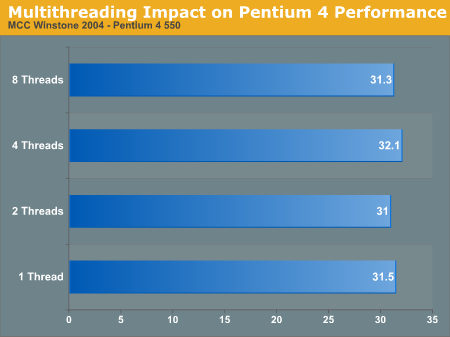
Despite the inclusion of Hyperthreading support, MCC Winstone 2004 still shows AMD performing much better in an area where Intel once dominated. While the Prescott based Pentium 4 560 is at the front of the Intel pack, it is still outperformed by the Athlon 64 3400+.
Here the single vs. dual channel memory gap shrinks to under 3% when we compare the 3400 and 3800+ processors, but also worth noting that the added cache of the 4000+ is also only responsible for about a 2% performance gain. Put the two together and you've got a decent combination in the Athlon 64 4000+, but separately the features don't bring much to the table to justify the added cost.
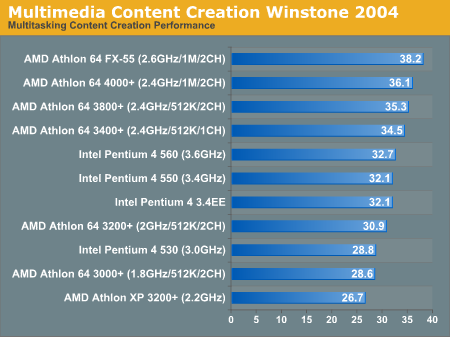
ICC SYSMark 2004
The first category that we will deal with is 3D Content Creation. The tests that make up this benchmark are described below:
"The user renders a 3D model to a bitmap using 3ds max 5.1, while preparing web pages in Dreamweaver MX. Then the user renders a 3D animation in a vector graphics format."
Intel has historically done very well under SYSMark 2004, especially when it comes to Internet Content Creation applications. Here we've got a number of very NetBurst friendly applications running at the same time and the results aren't too surprising.
For once we have the Pentium 4 560 out on top, distancing itself from the Athlon 64 FX-55 by almost 5%. The Prescott core flexes its muscle as the longer pipeline does it no harm, with the Pentium 4 550 performing on level ground with the Northwood based 3.4EE.
The three 2.4GHz AMD chips settle in the middle of the pack, followed by the Pentium 4 530 and the remaining Athlon 64s and Athlon XP. 3D rendering continues to be a strongpoint for the Pentium 4, with the combination of 3D rendering and animation giving Intel the much needed lead here.
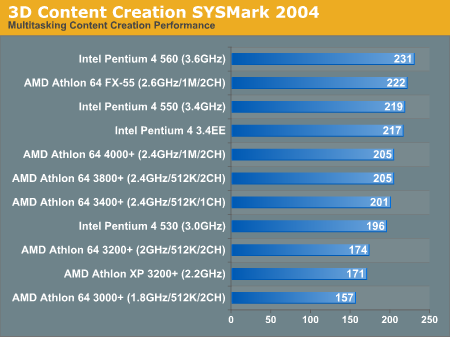
Next, we have 2D Content Creation performance:
"The user uses Premiere 6.5 to create a movie from several raw input movie cuts and sound cuts and starts exporting it. While waiting on this operation, the user imports the rendered image into Photoshop 7.01, modifies it and saves the results. Once the movie is assembled, the user edits it and creates special effects using After Effects 5.5."
The race is much closer in the 2D Content Creation test, with the Pentium 4 560 virtually tied for the lead with AMD's Athlon 64 FX-55.
Once again we see no difference between the 512KB L2 3800+ and the new 4000+ armed with a 1MB L2 cache. There continues, however, to be a slight performance impact when going down to the single channel Athlon 64 3400+.
Looking at the Athlon XP we see just how important the Athlon 64 has been
to AMD, without it we'd be analyzing another Intel dominated test.
Here's another situation where Prescott seems to be breaking even when
it comes to performance. Remember that Prescott's lengthened pipeline should
penalize it significantly, but thanks to Prescott's other core optimizations
and larger cache it manages to perform just as well as the Northwood based
Extreme Edition here.
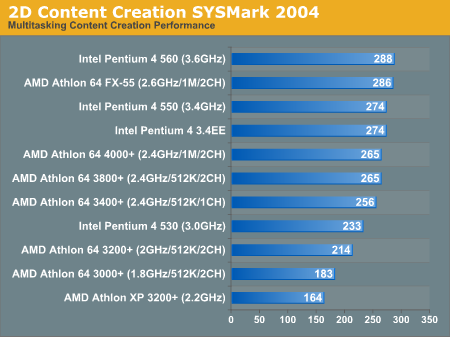
The Internet Content Creation suite is rounded up with a Web Publishing performance test:
"The user extracts content from an archive using WinZip 8.1. Meanwhile, he uses Flash MX to open the exported 3D vector graphics file. He modifies it by including other pictures and optimizes it for faster animation. The final movie with the special effects is then compressed using Windows Media Encoder 9 series in a format that can be broadcast over broadband Internet. The web site is given the final touches in Dreamweaver MX and the system is scanned by VirusScan 7.0."
The situation remains mostly unchanged in SYSMark's final Internet Content Creation test. The Pentium 4 560 heads up the pack, followed very closely by the Athlon 64 FX-55 as well as the Pentium 4 550 and 3.4EE.
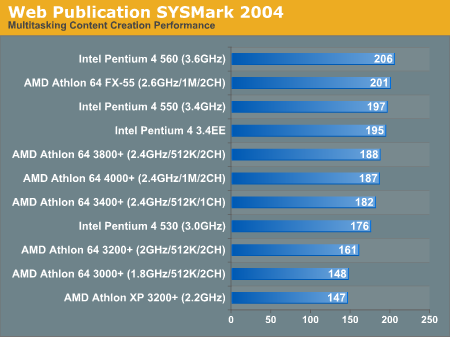
Mozilla + Media Encoder
While AMD dominated in WorldBench 5's Mozilla test, encoding a file using Windows Media Encoder in the background not only makes this test more appreciative of the Pentium 4 but also of Hyper Threading.
Despite the seemingly perfect Hyper Threading scenario, it doesn't help Intel win the lead here. The Athlon 64 FX-55 and the 4000+ manage to win here, followed by the 3.4EE. Without any spatial locality between the two very different applications being run enabling Hyper Threading essentially gives each one of the applications half of the cache they would have running solo, thus giving the 3.4EE an advantage over the Pentium 4 560.
We also see that the cache advantage is clearly present on the AMD side as well, with the 4000+ enjoying a 6.7% advantage over the 3800+, with the only difference between the chips being an additional 512KB of L2 cache.
The rest of the results are no surprise given the leaders, the Athlon 64 continues to be quite strong here.
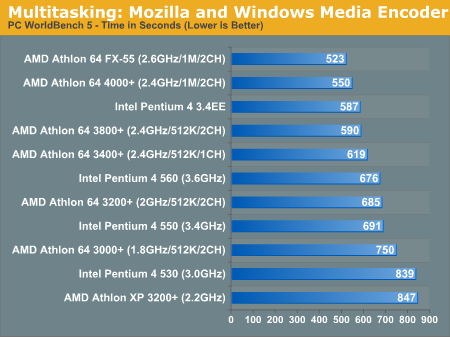










89 Comments
View All Comments
skiboysteve - Tuesday, October 19, 2004 - link
On the Business winstone 2004..."The Pentium 4 550 and Athlon 64 3800+ tie in the middle, while the 3400+ offers statistically similar performance."
No they didnt.
microAmp - Tuesday, October 19, 2004 - link
Very nice article, loved the L2 cache and memory comparisons at the end.thermalpaste - Tuesday, October 19, 2004 - link
Way back in 2000, I felt that Intel was doing something stupid by introducing the Willamette.The thunderbird was faster than the p-III coppermine at the same clock speeds, but considering that the p-III just had 2 parallel FPUs compared to the 3 on the athlon. An additional FPU would have helped of course. though the P-III core was not able to sustain higher clock speeds , intel could have redesigned a marginally deeper pipeline on the same core rather than designing the pentium-4 with a mammoth 20 stage pipeline.
Now the prescotts come with a 30-odd stage pipeline, but the integer unit runs at twice the speed which doesn't make the 7th generation of processors from intel very 'scalable'. Besides the processor heats upto 70 odd degrees with consummate ease (Im staying in India where the avg. room temperature is something like 29 degrees Celsius) and is not overclocker friendly.
I am waiting for the newer chips from Intel, based on the Pentium-M a.k.a the P6 architecture.
AMD is way ahead of Intel as of now.
skiboysteve - Tuesday, October 19, 2004 - link
Athlon 64 4000+ - 2.4GHz - 1MB - 128-bitAthlon 64 3800+ - 2.4GHz - 512KB - 128-bit
Athlon 64 3400+ - 2.4GHz - 1MB - 64-bit
Athlon 64 3400+ - 2.4GHz - 512KB - 64-bit
Athlon 64 FX-53 - 2.4GHz - 1MB - 128-bit
these numbers look off.
Your saying there are two s754 3400+, and one has more cache?
eva2000 - Tuesday, October 19, 2004 - link
why leave out the 3700+ s754 1MB from suhc a nice comparison :)miketheidiot - Tuesday, October 19, 2004 - link
excellent article. I agree with #2 that I would have liked to see an overclocking comparison, or at least a quick demonstation of the 4000 and fx-55. Still a great article though.GhandiInstinct - Tuesday, October 19, 2004 - link
We can always marvel at them but the prices, realistcaly speaking is a waste of our time. I'm as interested in the FX-55 as much as the IBM super-computer blue.Zac42 - Tuesday, October 19, 2004 - link
I especially liked the comparrison of the equally priced value procs at the end of the article. Nice way to sum up the graphs. Good overall comparison, as you guys have just about any possible app one could use on a PC. Now we just need an OC comparrison, and we will be set!DrMrLordX - Tuesday, October 19, 2004 - link
Nice article so far, still reading it, but I would like to know where the 925XE chipset-based P4 board was in this review? Are those available to you guys yet? Just wondering.